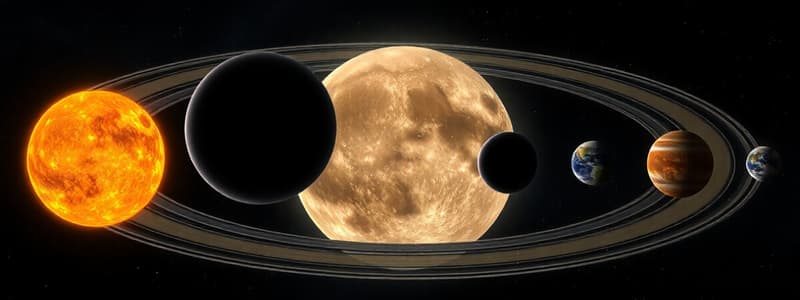Podcast
Questions and Answers
What does Newton's Law of Universal Gravitation explain?
What does Newton's Law of Universal Gravitation explain?
- The gravitational force is independent of distance between celestial bodies.
- The motions of a binary system can be derived from Kepler's laws. (correct)
- The speed of a planet in its orbit varies inversely with its mass.
- The mass of a planet directly affects the size of its orbit.
Which variable in the gravitational force equation represents the distance between a planet and the Sun?
Which variable in the gravitational force equation represents the distance between a planet and the Sun?
- r (correct)
- M
- F
- m
According to Newton's form of Kepler’s third law, which of the following correctly relates the parameters of a planet's orbit?
According to Newton's form of Kepler’s third law, which of the following correctly relates the parameters of a planet's orbit?
- $P^2 = m^3$
- $P^2 = a^3$ without any constants
- $P^2 = 4\pi^2 a^3$ (correct)
- $P^2 = G M a^3$
What conclusion can be drawn from the fact that Kepler’s law also applies to asteroids and comets?
What conclusion can be drawn from the fact that Kepler’s law also applies to asteroids and comets?
What factor affects the time taken for a planet to finish one orbit around the Sun according to Kepler’s law?
What factor affects the time taken for a planet to finish one orbit around the Sun according to Kepler’s law?
Which of the following planets is classified as an inner planet?
Which of the following planets is classified as an inner planet?
What distinguishes outer planets from inner planets?
What distinguishes outer planets from inner planets?
What is one of the main purposes of planetary exploration missions?
What is one of the main purposes of planetary exploration missions?
Which element is NOT associated with determining a planet's ability to retain gases in its atmosphere?
Which element is NOT associated with determining a planet's ability to retain gases in its atmosphere?
What can be inferred about asteroids and comets?
What can be inferred about asteroids and comets?
What is the correct order of the inner planets?
What is the correct order of the inner planets?
Which of the following best explains the significance of measuring magnetic fields in space missions?
Which of the following best explains the significance of measuring magnetic fields in space missions?
Which of the following is NOT one of the eight principal planets in our Solar System?
Which of the following is NOT one of the eight principal planets in our Solar System?
Which planet among the eight planets does not have an appreciable atmosphere?
Which planet among the eight planets does not have an appreciable atmosphere?
What is the escape temperature for molecular oxygen on Earth?
What is the escape temperature for molecular oxygen on Earth?
Which factor is crucial in determining a planet's ability to retain gases in its atmosphere?
Which factor is crucial in determining a planet's ability to retain gases in its atmosphere?
What is the average density range of terrestrial planets?
What is the average density range of terrestrial planets?
What is the dominant gas in the atmosphere of Titan?
What is the dominant gas in the atmosphere of Titan?
Which type of planets are primarily composed of light elements such as hydrogen and helium?
Which type of planets are primarily composed of light elements such as hydrogen and helium?
What is the average density of water?
What is the average density of water?
What do absorption features in a planet’s spectrum reveal?
What do absorption features in a planet’s spectrum reveal?
What factors contribute to a planet's ability to retain gases in its atmosphere?
What factors contribute to a planet's ability to retain gases in its atmosphere?
What happens to gas particles when their thermal speed exceeds the escape speed of a planet?
What happens to gas particles when their thermal speed exceeds the escape speed of a planet?
How is the escape speed from a planet calculated?
How is the escape speed from a planet calculated?
Which factor will NOT contribute to the likelihood of retaining gas particles in a planet's atmosphere?
Which factor will NOT contribute to the likelihood of retaining gas particles in a planet's atmosphere?
What does a higher temperature do to gas retention on a planet?
What does a higher temperature do to gas retention on a planet?
In the context of atmospheric gases, which gas will tend to escape more easily from a planet’s atmosphere?
In the context of atmospheric gases, which gas will tend to escape more easily from a planet’s atmosphere?
Which constant is used in calculating the average speed of a gas at a given temperature?
Which constant is used in calculating the average speed of a gas at a given temperature?
What is the relationship between gas mass and escape from a planet's gravity?
What is the relationship between gas mass and escape from a planet's gravity?
Which planet has the strongest magnetic field?
Which planet has the strongest magnetic field?
What generates the magnetic fields of Jupiter and Saturn?
What generates the magnetic fields of Jupiter and Saturn?
How is the diameter of a planet determined?
How is the diameter of a planet determined?
Which of the following cannot be used to determine the chemical composition of a planet?
Which of the following cannot be used to determine the chemical composition of a planet?
Which planet does not have a magnetic field?
Which planet does not have a magnetic field?
Which planets are classified as Jovian planets?
Which planets are classified as Jovian planets?
What is used to infer the internal structure of planets?
What is used to infer the internal structure of planets?
What role do gravity and distance to the Sun play in the solar system?
What role do gravity and distance to the Sun play in the solar system?
Flashcards are hidden until you start studying
Study Notes
Our Solar System Overview
- The solar system comprises the Sun, eight planets (Mercury, Venus, Earth, Mars, Jupiter, Saturn, Uranus, Neptune), and various celestial bodies including moons, asteroids, comets, meteoroids, and dust.
- Exploring the solar system reveals secrets about our origins, celestial processes, and life.
Planetary Classification
- Planets are categorized into inner (terrestrial) planets: Mercury, Venus, Earth, Mars; and outer (Jovian) planets: Jupiter, Saturn, Uranus, Neptune.
- Inner planets are Earth-like with rocky compositions, while outer planets are gas giants.
Laws of Motion
- Newton’s Law of Universal Gravitation explains planetary motion and is built upon Kepler’s laws, establishing a relationship between mass, distance, and gravitational force.
- Kepler’s third law can be expressed mathematically to describe the orbital characteristics of planets and satellites.
Atmosphere Retention
- The ability of a planet to retain gases in its atmosphere is influenced by its mass, gas composition, and temperature.
- Escape velocity, determined by the planet's mass and radius, influences whether gas particles can maintain their presence in the atmosphere.
- Terrestrial planets, due to weak gravity and high temperatures, lose light gases more easily, whereas Jovian planets retain lighter gases despite lower temperatures.
Composition and Density
- The average density of a planet provides insight into its material composition: terrestrial planets have densities ranging from 4000-5500 kg/m³ (rocky materials with iron cores), while Jovian planets have lower densities of 700-1700 kg/m³ (primarily light elements like hydrogen and helium).
- Spectroscopy is used to analyze the chemical composition of planetary atmospheres and surfaces.
Magnetic Fields
- Magnetic fields vary among planets, with Earth and Mars showing magnetized regions, while Venus lacks a strong field possibly due to its slow rotation.
- Jovian planets possess strong magnetic fields due to liquid metallic hydrogen or ionized water molecules; Jupiter has the strongest magnetic field in the solar system.
Planetary Properties Determination
- Properties of planets are determined through various methods:
- Orbital period and distance through direct observation and parallax.
- Size via angular size and small-angle formulas.
- Mass calculated using Newton’s version of Kepler’s third law.
- Density derived from mass-to-volume ratios.
- Chemical composition assessed using spectroscopic observations.
- Magnetic fields studied with magnetometers.
- Internal structure inferred from geological activity and magnetic data.
Key Terms and Concepts
- Asteroids and comets are distinct celestial objects, with asteroids generally being rocky while comets contain significant amounts of icy material.
- The escape temperature indicates a planet's potential to retain atmospheric gases, influenced by mass and distance from the Sun.
- The classification of celestial bodies influences our understanding of the solar system's evolution and dynamic processes.
Studying That Suits You
Use AI to generate personalized quizzes and flashcards to suit your learning preferences.



